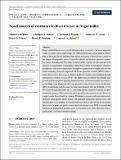Novel sources of resistance to blast disease in finger millet

View/
Publication Date
2020Author
Mathews M. Dida1 Chrispus A. Oduori2 Samuel J. Manthi3, 4 Millicent O. Avosa3 Erick O. Mikwa3 Henry F. Ojulong3 Damaris A. Ode
Metadata
Show full item recordAbstract/
Finger millet (Eleusine coracana (L.) Gaertn. subsp. coracana) is the most important
millet in eastern Africa and perhaps the oldest domesticated cereal grain in Africa.
One of the major factors limiting finger millet production is blast disease caused by
the fungus Magnaporthe grisea. Crop wild relatives and landraces present a potential source of novel genes. This study investigated the response of cultivated and wild
relatives of finger millet to an isolate of blast disease from western Kenya. Previous
germplasm collections were purified through two generations of single-seed descent
before screening alongside improved and farmer-preferred varieties (FPVs) under a
screen house across three seasons. Farmer-preferred varieties were identified through
participatory varietal selection (PVS). The plants were inoculated twice during each
growth period using hand-spraying method and data on disease incidence recorded at
grain-filling stage. Genotypic data was generated using diversity arrays technology
(DArT) sequencing and data analysis done using Genstat 18.2 and TASSEL 5.2.58.
We observed high heritability (81%), indicating that the variation observed was predominantly genetic. Wild accessions were generally more resistant to the disease in
comparison to the cultivated accessions. Preliminary genome-wide association study
(GWAS) using general linear model with principal component analysis led to the
identification of 19 markers associated with blast disease that will be be developed
into assays for genotype quality control and trait introgression. Wild accessions and
landraces of finger millet present a good reservoir for novel genes that can be incorporated into crop improvement programs.
